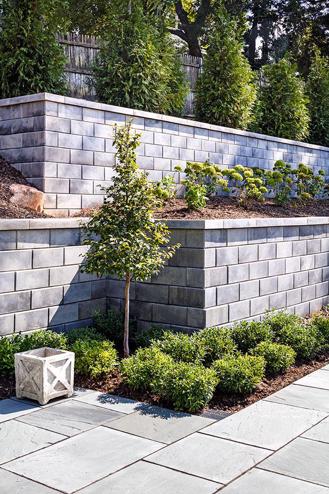The 3-Minute Rule for Retaining Wall And Garden Wall Construction
Wiki Article
The 7-Second Trick For Retaining Wall And Garden Wall Construction
Table of ContentsGetting My Retaining Wall And Garden Wall Construction To WorkThe Best Guide To Retaining Wall And Garden Wall ConstructionRetaining Wall And Garden Wall Construction for Beginners10 Simple Techniques For Retaining Wall And Garden Wall ConstructionThe Best Guide To Retaining Wall And Garden Wall Construction
If this slope is not controlled, the wall will relocate or fall short. Rainwater that runs off the top of a maintaining wall surface can harm the dirt and also plants on either side, deteriorating them away. Water drainage systems divert this water from at risk locations, reducing the impact to the structure and its surroundings.:max_bytes(150000):strip_icc()/SupremeGreenRetainingWall-9efab78277414e04b35a623abe3c39c6.jpg)
All retaining wall surfaces must include water drainage rock even if a draining pipes pipeline is not required. Area filter material above the water drainage stone and listed below the topsoil. That stops fine product and also natural matter from clogging up the water drainage stone.
5 Simple Techniques For Retaining Wall And Garden Wall Construction
Clay or other inadequate draining soils lag the wall surface. There are buried water sources within 50 feet of the preserving wall place 5. There are electrical outlet options for your drain pipeline. Whichever one you pick, position an electrical outlet at the very least every 30 to 50 feet along the wall surface. Inadequately drainage will reduce the life of your preserving wall.
:max_bytes(150000):strip_icc()/SupremeGreenRetainingWall-9efab78277414e04b35a623abe3c39c6.jpg)
Man-made wall surface used for supporting dirt in between 2 various elevations Keeping wall surfaces are reasonably rigid walls used for supporting dirt side to side to make sure that it can be retained at different levels on both sides. Preserving wall surfaces are frameworks designed to restrain soil to a slope that it would not naturally maintain to (typically a steep, near-vertical or vertical slope).
Top Guidelines Of Retaining Wall And Garden Wall Construction
A preserving wall that keeps dirt on the behind as well as water on the frontside is called a seawall or a bulkhead. A maintaining wall is developed to keep in area a mass of planet or the like, such as the edge of a balcony or excavation. The framework is built to resist the side pressure of soil when there is a wanted modification in ground elevation that goes beyond the angle of repose of the soil.These are cantilevered from a ground and increase over the grade on one side to preserve a higher level quality on the opposite side.

This reduction decreases the stress on the preserving wall. The most important consideration in appropriate style as well as setup of maintaining wall surfaces is to acknowledge as well as counteract the tendency of the preserved product to relocate downslope because of gravity. This produces lateral earth pressure behind the wall surface which relies on the angle of interior friction (phi) and also the natural toughness (c) of the maintained material, as well as the instructions and size of activity the maintaining structure undertakes.
Retaining Wall And Garden Wall Construction Fundamentals Explained
Water drainage materials will certainly reduce or get rid of the hydrostatic stress and enhance the security of the material behind the wall. Drystone preserving walls are typically self-draining. As an instance, the International Building Code requires maintaining wall surfaces to be developed to make sure security versus overturning, moving, too much structure pressure and water uplift; which they be made for a safety element of 1. Different kinds of preserving walls Construction kinds of gravity maintaining wall surfaces Gravity wall surfaces rely on their mass (stone, concrete or other heavy material) to resist pressure from behind as well as might have a 'batter' problem to enhance stability by leaning back toward the maintained soil. For short landscaping walls, they are often made from mortarless stone or segmental concrete units (masonry units).Diaphragm wall surfaces are pricey walls, yet they conserve time and room, as well as hence are made use of in metropolitan constructions. Sheet heap keeping wall surfaces are typically utilized in soft soil as well as limited areas.

Getting The Retaining Wall And Garden Wall Construction To Work
A secured retaining wall can be created in any one of the aforementioned designs yet also includes extra toughness using cable televisions or other remains anchored in the rock or dirt behind it. Generally driven click for more info into the product with boring, anchors are then increased at the end of useful source the wire, either by mechanical methods or frequently by injecting pressurized concrete, which broadens to develop a bulb in the soil.Report this wiki page